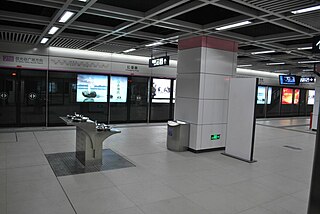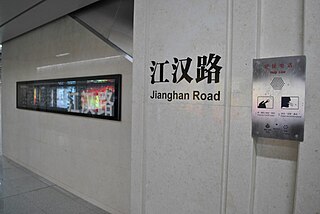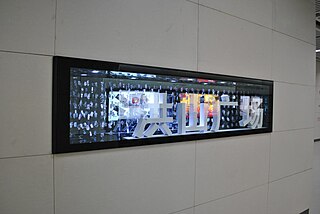
Hangzhou Metro is a metro system that serves the Chinese city of Hangzhou and surrounding suburbs. The system opened on November 24, 2012, with major expansion plans still ongoing, including a connection to neighboring Shaoxing which is building its own metro. It is the 17th city in China to operate a rapid transit system.

Chengdu Metro is the rapid transit system of Chengdu, the capital of Sichuan Province, China. The system has six lines in operation. Line 1 was opened on 27 September 2010, making it the first heavy-rail metro line in southwest China. ; and Line 2 began operations in September 2012. Line 4 opened to public at the end of December 2015, while Line 3 opened in July 2016. Metro lines are operated by Chengdu Metro Limited Liability Company. Commuter rail lines such as the Chengdu–Dujiangyan intercity railway are operated by Chengdu City Commuter Railway Limited Liability Company. It is China's first joint venture between a local government and China's national rail operator. The city and the Ministry of Railways worked together in building metro lines and high speed commuter rail lines. A light rail system northwest of Chengdu began construction at October 2015, and will open to public in 2017. There are currently over 350 km (220 mi) of subway lines under construction in Chengdu.

Zhengzhou Metro is a rapid transit rail network serving urban and suburban districts of Zhengzhou, the capital city of Henan province. It is operated by the state owned Zhengzhou Metro Group. As of November 2018, the network has 3 operational lines, with a network length of 93.7 kilometres (58.2 mi) and 59 stations. Opened on 26 December 2013, it is the first and currently the only operational metro system in Henan, and 18th in mainland China.

Tanwei Station, formerly Datansha South Station (大坦沙南站) and Datansha Station during planning, is an elevated station on Line 5 of the Guangzhou Metro and an underground station on Line 6. It is located at Zhongshuangqiao Park (中双桥公园) on Datansha Island in the Liwan District. It opened on 28 December 2009. It became an interchange station between Line 5 and Line 6 on 28 December 2013.

Hefei Urban Rail Transit abbreviated Hefei Metro is a rapid transit system in Hefei, China. Line 1 begun construction on 1 June 2012 and was opened on December 26, 2016. Line 2 opened exactly a year later. Thales Saic Transport is providing the line with urban rail traffic management and CBTC systems.

The Line 1 of Wuhan Metro is an elevated metro line in the city of Wuhan, Hubei. It is the longest continuous metro viaduct in the world. Line 1 opened on 28 July 2004, making Wuhan the fifth city in mainland China to have a metro system after Beijing, Tianjin, Shanghai, Guangzhou. This is the first Metro line in China wrongly referred to as a light rail line in Chinese terminology because it is elevated. Originally a branch line was planned to cross the Yangtze to Wuchang District via the Second Wuhan Yangtze River Bridge. The Second Wuhan River Bridge even had a provision in the central median where Line 1 trains would run in anticipation for the branch line when it opened in 1995. However by 2003 the reservation was removed to allow for more traffic lanes when the bridge was undergoing renovation.

The Line 2 of Wuhan Metro is the first underground metro line crossing the Yangtze River. This line has started trial run on September 25, 2012, and has opened on December 28, 2012. It is Wuhan's second metro line after Line 1, and the city's first underground line, since Line 1 is mostly elevated. Line 2 runs in a northwest-southeast direction, connecting Hankou and Wuchang, including Hankou Railway Station and major commercial districts.

Jinmalu station is an interchange station between Line 2 and Line 4 of the Nanjing Metro. It is located to the north of Jinma Road and south of Benma Road (奔马路), parallel to Shishi Road (石狮路) in Qixia District. It started operations on 28 May 2010 along with the rest of Line 2; the interchange with Line 4 opened on 18 January 2017 along with the rest of that line.

Xunlimen Station is an interchange station between Line 1 and Line 2 of the Wuhan Metro. It entered revenue service along with the completion of Line 1 on July 28, 2004. The Line 2 platforms opened on December 28, 2012. It is located between Jianghan District and Jiangan District.

Changgang Road Station, is a station of Line 2 of Wuhan Metro. It entered revenue service on December 28, 2012. It is located in Jianghan District. The old name is Jinse Yayuan Station.

Jianghan Road Station, is an interchange station and Line 2 and Line 6 of the Wuhan Metro. It entered revenue service on December 28, 2012. It is located in Jianghan District.

Hongshan Square Station, is a interchange station of Line 2 and Line 4 of Wuhan Metro. It entered revenue service on December 28, 2012. It is located in Wuchang District.

Zhongnan Road Station, is a interchange station of Line 2 and Line 4 of Wuhan Metro. It entered revenue service on December 28, 2012. It is located in Wuchang District.

Yangjiawan Station, is a station of Line 2 of Wuhan Metro. It entered revenue service on December 28, 2012. It is located in Donghu New Technology Development Zone.

Optics Valley Square Station is an station of Line 2 of the Wuhan Metro. It served the southeastern terminus of the line until February 19, 2019, when the extension of Line 2 to Fozuling opened. It entered revenue service on December 28, 2012. It is located in Donghu New Technology Development Zone. It is one of the busiest stations in the Wuhan Metro network serving 210,000 people on May 1, 2014.

Huangjinkou Station, is the terminus of Line 4 of Wuhan Metro. It entered revenue service on December 28, 2014. It is located in Hanyang District.
Wutangguangchang station is a station of Line 3 of the Nanjing Metro. It started operations on 1 April 2015. It is one of nine stations on Line 3 that are decorated with a Dream of the Red Chamber theme.

The Line 3 of Wuhan Metro is a metro line in Wuhan.. This line crosses five districts of Wuhan: Jiang'an District, Jianghan District, Qiaokou District, Hanyang District and Hannan District, and is the first line to cross the Han River. It started operation on December 28, 2015.



















